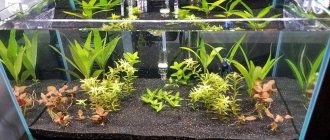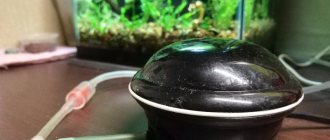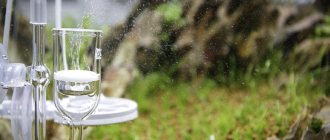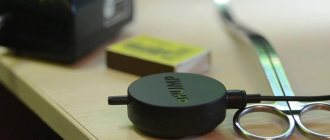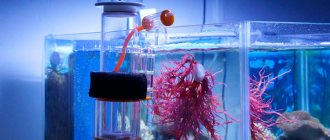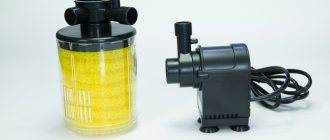The best scraper for an aquarium. A coating of algae and waste products of microorganisms forms on the surface of the glass of an artificial home pond. To remove contaminants, use a special factory-made tool. The owner can reduce costs and make an aquarium scraper with his own hands, using available materials.
Types of scrapers for cleaning an aquarium
To clean the inside of aquarium glass, use scrapers:
Equipped with a pad with a sponge or rubber working part, aimed at removing light dirt;
Equipped with a steel blade capable of cutting off hard plaque;
Consisting of 2 parts with magnets, the section located inside the container has a rough surface that removes dirt;
Combined, providing improved glass processing (for example, options with a sponge and a steel blade).
Sponge device
The tool is equipped with a handle with a plastic platform on which a thick sponge is attached.
The sponge device is equipped with a handle.
To remove dirt, you need to press the cleaning element against the glass and make up and down movements, gradually removing plaque. The sponge should be washed periodically with water.
Equipment advantages:
- ease of use;
- possibility of adjusting the handle on some models.
Flaws:
- the occurrence of noise during operation, which negatively affects the fish;
- ingress of some sediment into the water and bottom soil;
- inability to erase a dense layer of dirt.
Model with blade
To remove thick deposits on the walls, use devices with a safety razor blade or a special steel plate with a sharpened edge. The handle allows you to reach dirt near the bottom of the aquarium. Some manufacturers use a hinge to connect the handle and the working element, allowing you to clean hard-to-reach areas.
The model with a blade is used to remove dense plaque.
The benefits include:
- the ability to quickly clean heavy contaminants;
- the presence of a hinged head, which allows you to process surfaces at different angles;
- increased service life of the working edge.
Flaws:
- risk of damage to glass surfaces;
- formation of corrosion spots on the tool;
- Difficulty in replacing the blade on some scrapers.
Magnetic scraper
The device consists of a cleaning element and a separate handle, equipped with permanent magnets. To clean, you need to install sections on different sides of the glass; the surface of the internal element with a brush will allow you to clean off soft deposits. The outer cover has a soft material attached to prevent damage to the glass.
A magnetic scraper will remove soft deposits.
The benefits include:
- the ability to clean the inner walls without putting your hands in the water;
- quiet operation, when cleaning there is no noise that disturbs the fish;
- Suitable for processing surfaces made of silicate or acrylic glass;
- positive buoyancy of the aquarium section due to voids in the body.
Flaws:
- poor quality of cleaning; if the working edge is damaged, streaks remain on the surfaces;
- opening of sections due to increased thickness of the aquarium wall or curved surface;
- damage to the glass by abrasive particles caught on the brush;
- ability to remove only soft deposits.
Combined models
Combined type products provide improved surface treatment through the use of several cleaning elements. For example, a blade cuts off hard deposits, and a soft brush removes remaining dirt without the risk of damaging the base material of the aquarium walls.
Unusual products for glamorous aquarists
The range of cleaning scrapers is quite extensive. Leading manufacturers of aquarium accessories such as Karlie, Penn Plax, Hobby, JBL, Hagen and several others offer scrapers of all types and a wide price range.
The world of glamor has also affected the sphere of aquarium accessories. For example, for wealthy lovers of decorative pet fish and connoisseurs of expensive things, the NANO Gold scraper was created, the blade of which is coated with gold. Such an instrument is a great gift for a goldfish lover, and can also become a source of pride for a collector.
The owner of the aquarium can decide for himself which cleaning tool is most suitable for him. It is important to remember one rule: you do not need to wait until the glass walls are covered with a thick layer of plaque. Cleaning the glass at least once a week will help keep your aquarium in perfect condition.
Video on how to clean an aquarium using a homemade scraper:
How to choose the right aquarium scraper
Light pollution
If a light coating of algae and bacterial waste products has formed on the glass of the aquarium, then a sponge or magnetic tool is suitable for cleaning.
Average pollution
You can remove medium deposits from glass with a kitchen sponge, but the method is not suitable for acrylic walls, since a hard cleaning surface can damage the surfaces.
Heavy pollution
Any plastic card or tool with a steel blade is suitable for cleaning from coarse dirt.
Most owners of rectangular aquariums use magnetic devices; regular treatment does not allow the formation of a durable coating. It is recommended to choose floating scrapers with a magnet; when lifted from the surface of the tank, the element will rise to the surface of the water.
If an acrylic tank is installed indoors, then it is strictly forbidden to use abrasive tools or blades that leave deep scratches on the surface. Only soft sponges or special cleaners that do not harm flora and fauna are suitable for cleaning plastic.
What to look for when purchasing
Be sure to pay attention to the brand of the product. You should not trust little-known manufacturers. You should not give preference to scrapers with a low price - this is a dubious option. The packaging must indicate the power of the product or the thickness of the glass. Having a comfortable ergonomic handle is extremely important. It is advisable that the scraper have beveled edges, so it will not damage the silicone seams of the aquarium. Remember, the more powerful the magnetic scraper, the more expensive it is.
Check all the seams on the product - there should be no burrs, they can scratch the glass. The work surface should also be uniform and smooth, but still hard enough to clean the glass. Sometimes magnetic scrapers are equipped with a blade, so be sure to check the tightness of its fit to the surface. And finally, don’t forget to take the receipt so that in case of a malfunction you can return the purchased item to the store.
Making a scraper with your own hands
The aquarium owner can make a scraper himself using available materials. There are various design schemes suitable for removing light contaminants or a durable layer of deposits. The low cost of a homemade tool allows you to reduce the cost of maintaining an aquarium.
Scraper with magnet
To make a magnetic scraper for an aquarium with your own hands, you will need 2 magnets (rectangular and any configuration), insulating tape and a piece of felt.
Before starting work, the material should be boiled to remove bacteria and increase elasticity. You will also need a plastic card, a roll of fishing line and a sewing kit. A homemade magnetic scraper sinks in water, so cleaning should be done carefully, avoiding the magnet coming off the glass.
Manufacturing algorithm:
- Wrap a rectangular magnet in felt and stitch the material.
- Place a plastic card on the side edge and secure with fishing line. The protruding part will allow you to remove dense deposits from the glass of the aquarium.
- Wrap the outer magnet with insulating tape to protect the surface of the artificial reservoir from damage.
- Check the functionality of the product.
Scraper with plastic card
Manufacturing algorithm:
- Cut out a metal corner and drill 4 holes to secure the handle and working element. The degree of bending of the plate determines the ergonomics of the tool.
- Attach a plastic card (for example, a telephone card or a discount card issued in chain stores). The use of a material with low strength prevents the formation of scratches on surfaces; as wear occurs, the edge is trimmed or another card is installed.
- Fix the handle from a steel knitting needle, the length depends on the depth of the aquarium.
- Check the functionality of the homemade design.
Scraper with blade
You can make a scraper from a sheet of PVC plastic and a fragment of a blade from a stationery knife. Before making a tool, you should decide on the width of the cutting edge and draw the outline of the future product on a PVC sheet. The use of plastic provides positive buoyancy to a homemade device for cleaning aquariums. Several layers of PVC are used for manufacturing, ensuring the rigidity of the scraper. The blade is secured with screws or screws and additionally fixed with epoxy glue.
An alternative method involves using a PVC water pipe and an angle bracket that allows you to secure a safety razor blade. The parts are held by friction; the owner can use handles of different lengths.
Some aquarists install an additional tube 70-80 mm long on the corner, at the end of which they make a slot for installing a blade. Making the tool takes up to 20 minutes.
Scraper with sponge
For production you need:
- Make a support platform from thick plastic.
- Attach the handle at an angle with screws or glue.
- Place a piece of dense foam rubber on an adhesive mixture that is resistant to water.
- Check the functionality of the homemade scraper.
Home care methods
We clean the glass from plaque and greens with a sponge, a brush, a magnet and a scraper
First of all, always clean the walls of the aquarium, which very often become covered with brown or green spots. This can be done with various devices, in particular scrapers.
Such devices are especially relevant in the presence of large-volume aquariums. There are three types of scrapers:
A scraper with a soft, sponge-like surface. It has a long handle and is convenient for cleaning glass in medium-sized containers.
Metal scrapers. The design includes a special knife for aquarium glass. Often there are double-sided models, with a sponge on the back side. Magnetic scrapers. Consist of two parts, with built-in strong magnets
Such devices are very convenient, but remember that they should be used with extreme caution. One grain of sand caught under the scraper and the walls of the aquarium will be irreversibly scratched.
Most often, they wash the walls using ordinary dish sponges. The hard side of such a sponge will help wash away heavy dirt, while the main dirt will be easily washed off with the soft side.
Another thing that is indispensable when cleaning an aquarium is an ordinary toothbrush. It allows you to thoroughly wash seams and objects with small parts.
We clean the bottom with a siphon, and without it
Cleaning the soil is the most labor-intensive process. In the first month after moving in, it is not necessary to wash it, but over time, pollutants accumulate in the soil - particles of food, fish feces, which begin to rot and release hydrogen sulfide, which is toxic to aquatic life.
This procedure can be carried out in two ways:
Using a siphon.
Using a cylinder - a funnel, stir up the soil, this will lift contaminants from the bottom and draw them into the siphon with the flow. Heavy soil will quickly fall into place. After clean water begins to appear from the pump tip, move on to the next section of soil.
After treating the entire surface, add fresh water. In the first hours it will be somewhat cloudy, but soon the suspension will settle and transparency will return.
And yes, siphons also have an automatic battery-powered model.
In case of severe contamination, it is necessary to completely remove the soil and rinse it under running water. No need to use chemicals.
If you are not ready to buy a pump in a store, you can make it yourself. All you need is a hose and an empty bottle with the bottom cut off. The inconvenience of this design is the need to suck air out of the hose, just as car owners do when they need to drain gasoline from the tank.
Changing the water
Changing water is one of the most important procedures for caring for a home pond. If you regularly do not add fresh water, the fish will begin to get sick and die.
This event is carried out simultaneously with siphoning the soil and cleaning the walls of the aquarium. If these actions help eliminate visible contaminants, then changing the water is designed to reduce the level of nitrates and phosphates. In addition, clean water contains minerals necessary for the health of fish. Substitution allows you to replenish these substances and regulate the acidity of the water.
Replacement should be done every 7-10 days. However, remember that in densely populated aquariums this should be done somewhat more often.
Usually 20–30% of the volume is replaced, and in a marine aquarium no more than 15% of the water.
In the case of a partial replacement, it is not necessary to settle tap water - in such quantities, chlorine is not dangerous for the inhabitants of the reservoir.
Features of using scrapers for cleaning an aquarium
Scrapers are designed to separate dirt from the vertical surfaces of the aquarium. It is not possible to treat plants or decorative items.
When working with the tool, be careful not to allow soil particles to get under the cleaning edges.
Cleaning frequency
The frequency of cleaning depends on the size of the aquarium and the number of plants. Under standard conditions, the procedure is carried out after 4-5 days, but planting algae allows you to increase the interval to 7 days. If plaque is detected on glass or decorative objects, unscheduled treatment should be carried out.
Plants and decor
The decor becomes covered with deposits, which are cleaned only after removing items from the aquarium. The products are washed in water using a toothbrush to remove dirt from small crevices. The driftwood is treated with solutions of soda or hydrogen peroxide, and then the remaining reagent and dirt are removed. When cleaning, do not use excessive force; rough movements can break the decor or peel off the paintwork.
Natural plants require periodic maintenance, which consists of trimming excessively long shoots and removing damaged parts. Overgrown algae that reduce the free space for fish to swim should be removed. Bushes should not block each other's light, otherwise plant growth will deteriorate. When removing algae with roots, you should hold the soil with your hand, reducing the release of dirt into the water.
Home care methods
We clean the glass from plaque and greens with a sponge, a brush, a magnet and a scraper
First of all, always clean the walls of the aquarium, which very often become covered with brown or green spots. This can be done with various devices, in particular scrapers.
Such devices are especially relevant in the presence of large-volume aquariums. There are three types of scrapers:
A scraper with a soft, sponge-like surface. It has a long handle and is convenient for cleaning glass in medium-sized containers. Metal scrapers. The design includes a special knife for aquarium glass. Often there are double-sided models, with a sponge on the back side. Magnetic scrapers. Consist of two parts, with built-in strong magnets
Such devices are very convenient, but remember that they should be used with extreme caution. One grain of sand caught under the scraper and the walls of the aquarium will be irreversibly scratched.
Most often, they wash the walls using ordinary dish sponges. The hard side of such a sponge will help wash away heavy dirt, while the main dirt will be easily washed off with the soft side.
Another thing that is indispensable when cleaning an aquarium is an ordinary toothbrush. It allows you to thoroughly wash seams and objects with small parts.
Important! If your aquarium “goes green” too often, eliminate the cause of the intense growth of algae: resettle the fish, reduce the amount of light entering the pond, change the water more often
We clean the bottom with a siphon, and without it
Cleaning the soil is the most labor-intensive process. In the first month after moving in, it is not necessary to wash it, but over time, pollutants accumulate in the soil - particles of food, fish feces, which begin to rot and release hydrogen sulfide, which is toxic to aquatic life.
This procedure can be carried out in two ways:
Using a cylinder - a funnel, stir up the soil, this will lift contaminants from the bottom and draw them into the siphon with the flow. Heavy soil will quickly fall into place. After clean water begins to appear from the pump tip, move on to the next section of soil.
After treating the entire surface, add fresh water. In the first hours it will be somewhat cloudy, but soon the suspension will settle and transparency will return.
And yes, siphons also have an automatic battery-powered model.
ATTENTION! If the entire bottom is covered with plants, cleaning with a siphon is not carried out. Cleaning without using a siphon is carried out for various reasons.
The main ones are severe pollution and an abundance of algae in the aquarium.
Cleaning without using a siphon is carried out for various reasons. The main ones are severe pollution and an abundance of algae in the aquarium.
In case of severe contamination, it is necessary to completely remove the soil and rinse it under running water. No need to use chemicals.
If you are not ready to buy a pump in a store, you can make it yourself. All you need is a hose and an empty bottle with the bottom cut off. The inconvenience of this design is the need to suck air out of the hose, just as car owners do when they need to drain gasoline from the tank.
Changing the water
Changing water is one of the most important procedures for caring for a home pond. If you regularly do not add fresh water, the fish will begin to get sick and die.
This event is carried out simultaneously with siphoning the soil and cleaning the walls of the aquarium. If these actions help eliminate visible contaminants, then changing the water is designed to reduce the level of nitrates and phosphates. In addition, clean water contains minerals necessary for the health of fish. Substitution allows you to replenish these substances and regulate the acidity of the water.
Replacement should be done every 7-10 days. However, remember that in densely populated aquariums this should be done somewhat more often.
Usually 20–30% of the volume is replaced, and in a marine aquarium no more than 15% of the water.
In the case of a partial replacement, it is not necessary to settle tap water - in such quantities, chlorine is not dangerous for the inhabitants of the reservoir.
Pisces helpers
There are special types of fish that help in the natural cleaning of the aquarium. The most beautiful and popular of them:
- Corydoras catfish get along with any species of fish. They will provide benefits only if there is a normal biological balance. If it is disturbed, the catfish will begin to harm: eat all the food, lift dirt from the bottom.
- Mollies eat algae, so you need to keep these fish in an aquarium with a lot of plants.
- Girinocheil Siamese has a striking, beautiful color. At a young age, the fish are calm, gnawing snags all day long. In old age, they begin to take food from others. In strong light they hide in rocks or raise mud from the bottom.
- It is not recommended to breed Pterygoplichts with bottom-dwelling fish. They will begin to divide the territory, injure each other, and after cleaning the entire aquarium of algae, they will begin to take care of the plants. To prevent this from happening, they need to be fed catfish food.
- Labeo protects its territory, a large fish. If you have two individuals at once, they will begin to have conflicts.
- Otocinclus cleans the aquarium from birth to old age. This is the most peaceful species of all listed. Five individuals are able to keep a 100 liter tank clean.
How the device works
In simple terms, a siphon is a regular pump. In general, it is a device for pumping out liquid. For example, water will be pumped out of an aquarium along with fish waste.
The main part of the tool is presented in the form of a suction tube. The principle of operation of a siphon for aquariums is very simple: one end of the tube is lowered tightly to the ground, and the second is placed as low as possible in relation to the level of the bottom of the aquarium. The outer tip is dipped into a jar or bucket. It is necessary to create a vacuum in the pipe, but this is a fairly simple procedure, similar to pumping gasoline out of a car using a rubber hose. Vacuum is created by sucking air through the mouth. Similar manipulations are carried out to launch a siphon in an aquarium.
The siphon makes cleaning the soil in the aquarium much easier
The liquid along with the waste will flow by gravity into the pipe and drain into a pre-prepared container. As a result, you need to wait until the dirt settles and drain the water back into the aquarium. The process is not particularly difficult. The auxiliary devices of commercial siphons for cleaning aquariums can be considered the result of scientific developments.
https://youtube.com/watch?v=QtjnjLJkLD4

